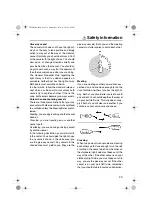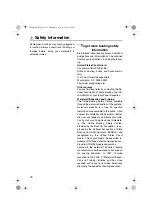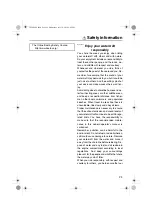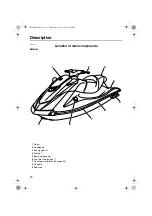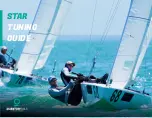
Safety information
19
Make sure that the rope is not looped
around anything.
After checking that the skier is ready and
that there is no traffic or other obstacles, ap-
ply enough throttle to raise the skier.
●
Make smooth, wide turns. The watercraft is
capable of very sharp turns, which could ex-
ceed the abilities of the skier. Keep the skier
at least 50 m (150 ft), about twice the dis-
tance of a standard ski rope, from any po-
tential hazard.
●
Be alert to the hazard of the ski rope handle
snapping back at the watercraft when the
skier falls or is unable to get up on the skis.
●
Towing heavy or bulky objects other than
skiers, such as another boat or watercraft,
can cause loss of steering control and cre-
ate a hazardous condition. If you must tow
another boat in an emergency situation, op-
erate slowly and cautiously.
EJU30961
Rules of the Road
Your Yamaha watercraft is legally consid-
ered a powerboat. Operation of the water-
craft must be in accordance with the rules
and regulations governing the waterway
on which it is used.
Just as there are rules that apply when you
are driving on streets and highways, there are
waterway rules that apply when you are oper-
ating your watercraft. These rules are used in-
ternationally, and are also enforced by the
United States Coast Guard and local agen-
cies. You should be aware of these rules, and
follow them whenever you encounter another
vessel on the water.
Several sets of rules prevail according to geo-
graphic location, but are all basically the same
as the International Rules of the Road. The
rules presented here in this owner’s/opera-
tor’s manual are condensed, and have been
provided for your convenience only. Consult
your local U.S. Coast Guard Auxiliary or De-
partment of Motor Vehicles for a complete set
of rules governing the waters in which you will
be operating your watercraft.
Steering and sailing rules
Whenever two vessels on the water meet one
another, one vessel has the right-of-way; it is
called the “stand-on” vessel. The vessel that
does not have the right-of-way is called the
“give-way” or “burdened” vessel. These rules
determine which vessel has the right-of-way,
and what each vessel should do.
Stand-on vessel
The vessel with the right-of-way has the duty
to continue its course and speed, except to
avoid an immediate collision. When you main-
tain your direction and speed, the other vessel
will be able to determine how best to avoid
you.
UF2M10E0.book Page 19 Wednesday, July 14, 2010 5:02 PM
Содержание VXS: VXR
Страница 12: ...General and important labels 7 UF2M10E0 book Page 7 Wednesday July 14 2010 5 02 PM ...
Страница 13: ...General and important labels 8 EJU35925 Other labels UF2M10E0 book Page 8 Wednesday July 14 2010 5 02 PM ...
Страница 107: ...UF2M10E0 book Page 3 Wednesday July 14 2010 5 02 PM ...
Страница 108: ...Printed in USA July 2010 0 2 1 CR YAMAHA MOTOR CORPORATION USA DIC183 ...
















